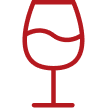2020 Sadie Family Treinspoor
| Type of Wine | Red |
|---|---|
| Country | South Africa |
| Region | Western Cape |
| Appellation | Swartland (Appellation) |
| Winery | Sadie Family |
| Vintage | 2020 |
| Grape | Tinta Barroca |
| Content (Alc) | 0.75 ltr (13.5%) |
| Drink window | 2022 - 2038 |
Eben Sadie is considered one of the pioneers in South African viticulture. Because of his insight it can be said that the Swartland region came to be seen in a completely different light. It was Eben who found the older vineyards here and made his famous Columella and Palladius.
Like all wines of the Sadie Family, this Treinspoor is a very scarce, great wine with an impressive aging potential. Like the big brother, this Treinspoor is made from the Tinta Barocca. In the glass, the wine has a bright ruby red color with a scent that opens slowly. It has a captivating bouquet with raspberries, cranberry leaf, tobacco and moist, wet clay-like aromas and lots of spiciness like cloves, nutmeg and some pepper. Followed by a good spicy taste with a fine acidity and refined tannins. The wine has firm tannins that can be compared to Barolo's and Barberesco's from Piemonte. This is a great South African wine.

After years of work in Priorat and the founding of Terroir al Limit, Eben Sadie has returned to his roots. To put it in his own words: "A winemaker should make wines in his region of origin. Where he should know the terroir best." The wine world has some heroes, and Eben Sadie is one of them.
Eben graduated as an oenologist in Elsenburg (South Africa). There he became integrated by the vine: a plant that offers so much diversity, 5000 varieties all over the world. Sadie traveled the world for 8 years, working both in companies that make 6 million liters of wine annually and in companies that only produce 6 barrels. He ended up in Germany, France, Spain, Austria, Oregon and California, before returning to his native South Africa. There he is now counted among the new guard winemakers who want to give the New World a better reputation.
He settled in Swartland (1999), a new wine region for South Africa. At the same time, he resolutely broke with the New World custom of making wines from a single grape variety: he chose blends of complementary grape varieties. He based the reason for this on a sober analysis: "All over the world, wines from different grape varieties are made in a Mediterranean, southern climate, while wines from a single grape variety mainly occur in a continental, more northern climate.
Most countries there enjoy a Mediterranean climate, but they still started making wines from one grape variety: Cabernet Sauvignon, Merlot, Chardonnay and so on. This was successful in the beginning, because it was new and because the grape variety was strongly placed in the foreground. But you don't make really great wines with that. As a result, the New World scores well in the lower price ranges, but is not seen as a supplier of great wines. I want to change that."
Sadie immediately put his vision into practice. He planted the grape varieties that give the best results in the southern Rhône region: Syrah, Grenache and Mourvèdre. 43 ha spread over 48 different plots, biodynamically treated and processed. He also managed to discover numerous old vineyards, restore them and give them a new lease of life (Ouwingerd series). And just like in the time of Terroir al Limit, he gave the wines individuality and provided them with his own signature, that of refinement.
The Swartland region extends north of Cape Town, between Durbanville and Piketberg, inland from the Atlantic Ocean, with Malmesbury in the middle. The region has a very stable climate, which means that a very consistent quality can be achieved every year. All grapes come from non-irrigated vineyards located in the Swartland region. Eben Sadie is a wine philosopher in many ways. As a result, he uses many old techniques in combination with experiments.
For example, he ferments parts of his wine in large concrete 'eggs', Stöckinger foeders, amphorae and he uses wooden barrels that have not been toasted. He has also started an experiment with fermenting in jars made from the soil around the winery and buried during the fermentation. This technique is very old and originates from the Balkan region.
| Type of Wine | Red |
|---|---|
| Country | South Africa |
| Region | Western Cape |
| Appellation | Swartland (Appellation) |
| Winery | Sadie Family |
| Grape | Tinta Barroca |
| Biological certified | No |
| Natural wine | No |
| Vegan | No |
| Vintage | 2020 |
| Drinking as of | 2022 |
| Drinking till | 2038 |
| Alcohol % | 13.5 |
| Alcohol free/low | No |
| Content | 0.75 ltr |
| Oak aging | Yes |
| Sparkling | No |
| Dessert wine | No |
| Closure | Cork |
| Parker rating | 96 |
| Tasting Profiles | Earthy, Rustic, Dark fruit, Dry, Fruity, Aged on wood, Powerful, Tannines, Full |
| Drink moments | Barbecue, Met vrienden, Open haard |













 Follow the latest news about all our wines, promotions, and new selections.
Follow the latest news about all our wines, promotions, and new selections.